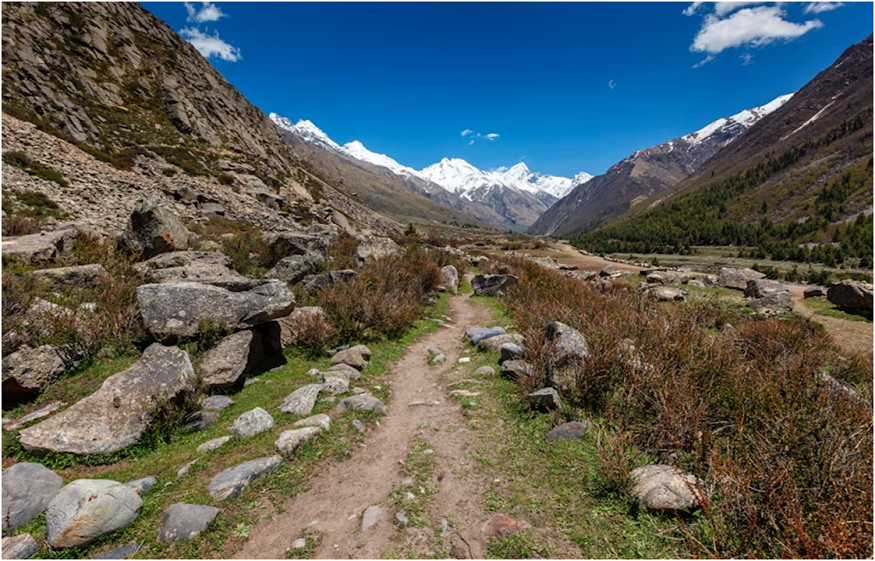Start of the Hidden Trail: Nar Phu Valley Trek
Nar Phu Valley trek is not famous like Everest, but it has something real, something raw. You start from Koto, not far from Annapurna Circuit, but instead of going to the big crowd side, you take a left, into the silence, into the wild. In Nar and Phu villages, they sit quietly between rock, wind, and prayer flags.
This trek is not just about walking. It’s about feeling.
Not many people go this way, so it still feels like old times. Villagers wear Tibetan-style clothes and speak a soft language mixed with time. Yaks walk like kings on trails. You go over Kang La Pass, and from the top, the view hits hard—Annapurna is all there, standing proud.
Walking here is not only about the body. It’s a spirit thing too. Stupas, mani walls, ancient monasteries—they all whisper stories if you walk slowly and listen right.
The teahouse is not big here, maybe a simple bed, warm dal bhat, and strong butter tea. But my heart is warm. In Phu village, the sky feels close, and stars come alive at night. Cold, maybe bitten, but heart full.
You finish the Nar Phu Trek and connect to the Annapurna Circuit, but your mind has already changed. You saw something secret. And now the journey goes on.
Annapurna Circuit with Tilicho Lake
After Nar Phu, the Annapurna Circuit feels bigger and wider. The trail got more people and more lodges, but it was still magic. From Chame to Manang, every turn shows a new face of the mountain. Pisang, Annapurna II, and Gangapurna—they come close like giants watching.
Manang is special. It’s a place where trekkers rest, breathe, and feel. From here, you can go to Tilicho Lake. That’s no normal detour. That’s a journey in itself.
Tilicho is not just a lake. It’s sacred, silent, and deadly beautiful. Blue water in a high-altitude basin, surrounded by ice walls—it looks like a dream. The trail to Tilicho is hard, sometimes with loose rocks, narrow paths, and landslide areas. But when you reach it, silence is loud. It speaks to you.
You sleep in Tilicho Base Camp, wake early, and climb slowly to the lake. No trees here, no sound, only wind and your heart. The lake sits quiet, the mirror of the sky. Some people cry here, not from pain, but because it is too beautiful to understand.
Back to the circuit, you face Thorong La Pass—5,416 meters. Highest point in the trek. Need to start early, maybe 4 AM, headlamp on, cold air biting. But every step takes you closer to the top. And from the top, the world feels small, the sky big, and you—somewhere in between.
Downhill to Muktinath, you feel different. Muscles hurt, but spirit is light. You passed something. Tilicho and Thorong La—they tested you, and you passed.
Manaslu Circuit Trek in 10 Days
Manaslu is not for everyone. It’s quieter, deeper, and older. In Manaslu Circuit trek in 10 days, you circle the eighth highest mountain in the world. Start from Soti Khola, follow rivers, cross suspension bridges, pass jungle, and slowly climb into the snow world.
Villages change as you climb. Gurung, then Tibetan-style. You eat dal bhat, sleep in small rooms, and hear the wind at night like mountain breathing.
Jagat, Deng, Namrung—names like poetry. Each village offers smiles, hot food, and prayer flags dancing in the sky.
Samagaon—the heart of Manaslu. Big mountains stand tall, glaciers close, and monasteries hum in the wind. You can hike to Manaslu Base Camp or rest and watch yaks graze near the river.
Larke La Pass, 5,160 meters, is hard. Long day. Start in the dark, climb slowly, and the cold air makes your breath short. But from the top, when the sun rises, you see Himlung, Cheo, Kang Guru, and Annapurna II all in one glance. That image doesn’t leave.
Descending to Bimtang, pine trees return, the air is warm, and tea tastes better. 10 days gone, but memories last forever. Manaslu does not shout like Everest. It whispers. And you never forget what it told you.
Makalu Base Camp Trek
Makalu, the fifth highest in the world, stands wild and proud. The trek to its base is not easy. Few go there. That’s why it is still raw. You fly to Tumlingtar, drive to Num, and begin from there.
The Makalu base camp trek trail goes up and down like life. Big climb, big drop. Forest thick, rivers loud, bridges shaky. But you keep going. Seduwa, Tashigaon—villages of warmth and green hills.
After Tashigaon, climb to Khongma Danda. That’s a hard day. Stone steps, endless. But the view comes as a reward. Snow peaks peeking, clouds running.
Passes come next—Shipton La, Keke La. High, windy, and cold. But on the other side, silence. Barun Valley. One of the most remote, silent, and holy valleys in the Himalayas.
Base Camp is pure. You stand in front of Makalu, 8,481 meters. Close. Giant. Ice falls down cliffs. Glaciers crackle at night. Air thin, but mind sharp.
There are not many tea houses here. Camping often. But that’s beauty. Fire under the stars. The food is simple—noodle soup, maybe potato. But the sky is full of stars. The Milky Way stretches above the tent.
Coming back feels different. You saw something wild. Not just mountains—wild inside you. Makalu shows you how strong and small you can be at the same moment.
The Common Thread
All these treks—Nar Phu, Annapurna Circuit with Tilicho, Manaslu, and Makalu—are different. Different terrain, people, and weather. But one thing is the same. They change you.
You start with a backpack, boots, and maybe a map. But on the trail, you lose your old self. You find a new rhythm—walk, breathe, see, feel. No internet, no rush. Just sky, stone, snow, and sweat.
Locals don’t speak much English but smile a lot. Their homes are simple, food honest. You sit, eat, share fire, and understand—this is real life. Not cities, not screens.
Mountains don’t care if you are rich or poor. They care if you respect them. You walk humble; they let you pass. You rush arrogantly; they push you back. That’s the rule.
Preparation Matters (But So Does Letting Go)
These treks are not for lazy legs. You need to prepare. Train legs, carry a backpack, and get gear right. Warm jacket, solid boots, sleeping bag, and water purifier—all are musts.
Permit needed. Nar Phu and Manaslu are restricted areas. I need a guide. Annapurna and Makalu are more flexible. But always better with a local guide. They know the weather, trails, and stories.
AMS—altitude mountain sickness—is real. Go slow. Drink water. Listen to the body. No shame in turning back. Pride can be dangerous.
But also let go. Let go of the plan and schedule. Sometimes landslides block the trail. Sometimes snow is delayed. Sometimes hearts tell you to stay one more night near a river. That’s okay.
Food and Accommodation
Nar Phu Valley Trek: Accommodation is mostly in basic teahouses run by locals. Facilities are simple, with limited electricity and shared toilets. Meals include dal bhat (rice, lentils, vegetables), noodle soups, momos, and Tibetan bread. The remote nature of the trek limits options, but the food is warm and filling.
Annapurna Circuit Trek with Tilicho Lake: This popular trek offers a wide range of accommodations — from basic teahouses to comfortable lodges in lower areas. Local and Western meals are widely available: pizza, pasta, eggs, dal bhat, porridge, and tea. At higher altitudes near Tilicho Lake, facilities are basic and food choices limited.
Manaslu Circuit Trek (10 Days): Teahouse accommodation is available throughout the trail, though more rustic than in Annapurna. Rooms are basic but clean, with warm blankets. Meals are mostly Nepali and Tibetan dishes — dal bhat, thukpa, tsampa, and potatoes.
Makalu Base Camp Trek: This remote trek has basic homestays and camping options. Lodging is simple and may require advance planning or porters with tents. Food is local — dal bhat, noodles, eggs — often cooked by the host families or your support crew.
Weather and Temperatures
Nar Phu Valley Trek: Spring (March–May) and autumn (Sept–Nov) offer clear skies and moderate temperatures (10–20°C in the day, below freezing at night above 4000m). Winter is harsh with snow-blocked passes.
Annapurna Circuit with Tilicho Lake: Best weather in spring and autumn. Daytime temps range 15–20°C at lower elevations; Tilicho Lake region drops below -10°C at night.
Manaslu Circuit Trek: Clear skies and stable weather in spring/autumn. Temperatures: 15–20°C daytime, down to -6°C at night near Larke La Pass.
Makalu Base Camp Trek: Spring and autumn are ideal. Days are mild (10–18°C), but nights near base camp drop to -10°C. Monsoon season brings heavy rain and leeches.
Why These Treks Matter Now
The world is getting crowded. Everest is too full. Pokhara is too touristy. But these treks—they are still secret. Still soul.
Nar Phu—untouched Tibet in Nepal. Annapurna Circuit with Tilicho lake —a mix of beauty and challenge. Manaslu—the perfect middle path, not crowded, not easy. Makalu—true wilderness, the way trekking should be.
If you want real Nepal, these paths take you there.
Final Footprint
In the end, it’s not just about walking distance or pass height. It’s about moments.
Sitting with a yak herder under a full moon.
Sharing a fire with a porter in a stone hut.
Hearing prayer wheels spin in the wind.
Crossing paths with tears and joy mixed.
You don’t come back the same. These treks—Nar Phu, Tilicho, Manaslu, and Makalu—leave a mark. Not on the body, but deeper.

